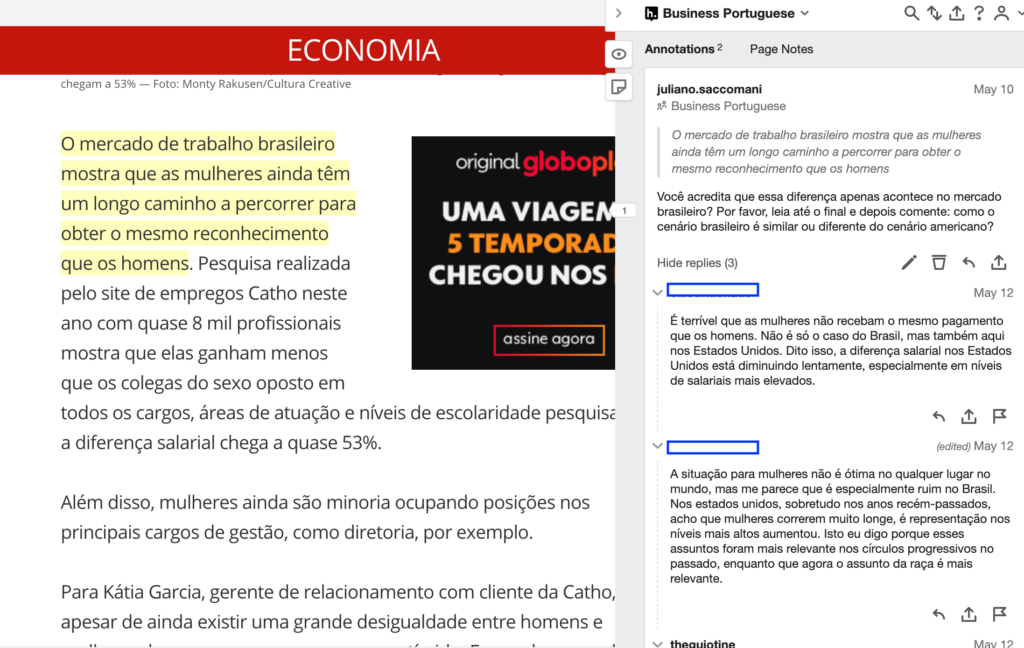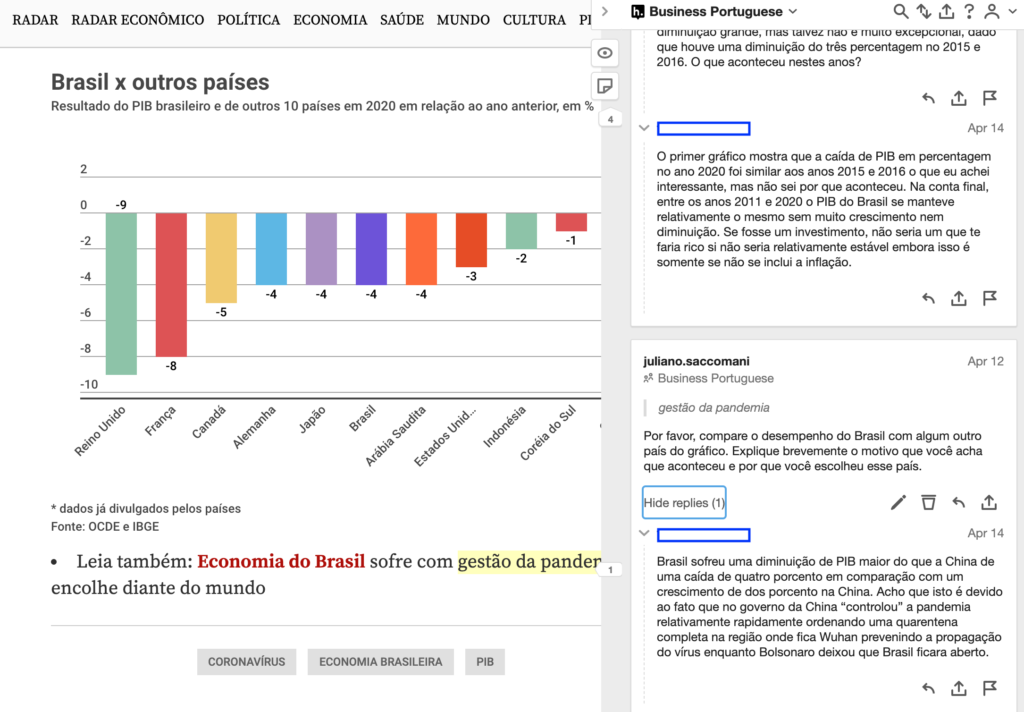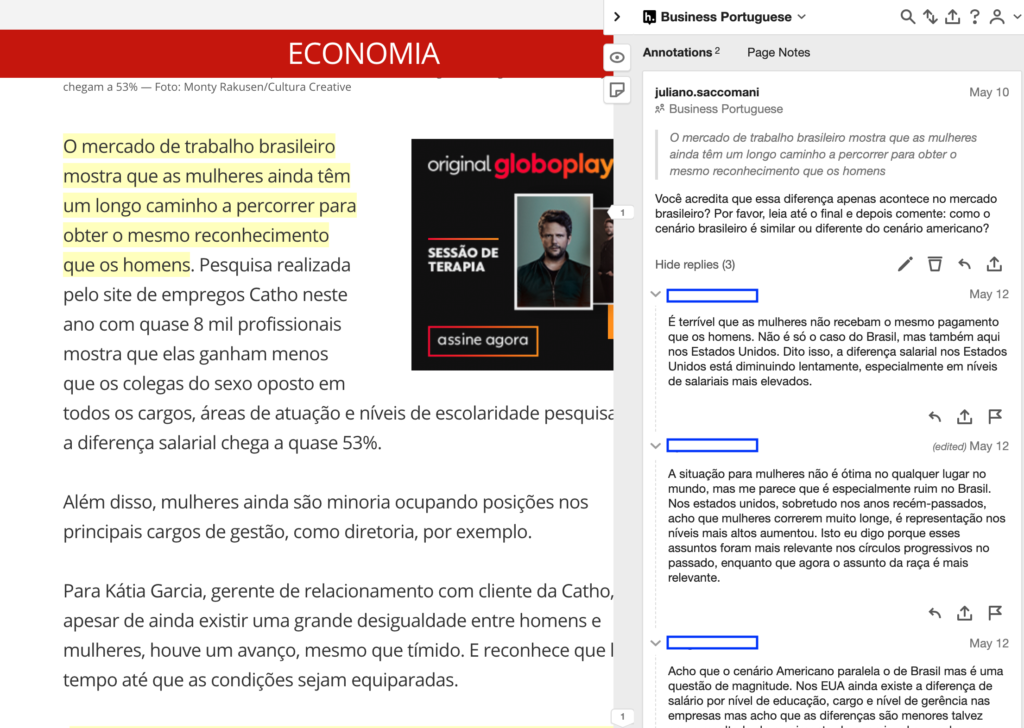Out with the old, in with the (carefully-curated) new

By Juliano Saccomani, Assistant Instructional Professor of Portuguese and Spanish, University of Chicago
As I write this in late-summer 2021, most of us are or will soon be inside a classroom again, looking our students in the eyes, and seizing all of the benefits that F2F teaching can offer (no more “you’re muted”). Nonetheless, I would be lying if I said that while teaching remotely I didn’t come across great online resources and tools that proved to be extremely helpful. I used so many new and exciting tools for so many different purposes that it would be a shame to leave them behind. However, we can’t just add any and all shiny forms of technology into our classes: integration needs a clear purpose, otherwise it is more likely to confuse than help. After an entire year of experience teaching online, attending several workshops, and taking three remote-teaching-focused courses at MSU, I have come to see how beneficial some tools can be when used with definite objectives in mind. For that, let me share with you some of the criteria that I use when picking resources to bring with me into my F2F teaching.
I teach Portuguese and Spanish for undergraduate students at a 4-year private university in the city of Chicago. Both programs structure their languages with a backwards design approach: we know what we want our students to be able to do by the end of each sequence, so we retroactively create our courses with those goals in mind. And to really try to make better use of the time we have together with the students, we always use the flipped model of teaching, in which students prepare for class beforehand so that we maximize the practice in F2F sessions. The languages I teach might be very similar linguistically and in terms of curricular goals, but the context is different: Spanish is one of the most widely-taught languages in the United States, whereas Portuguese is considered a less-commonly taught language (despite being the sixth most-widely spoken language in the world). With that, Spanish has a wide array of teaching resources available, and, frequently, institutions have various sections of the same class. Portuguese faces a lack of resources as well as relatively low enrollments, which comes with the constant risk of classes being cancelled before the semester even starts. Your teaching reality might be at either ends of the continuum or somewhere in between, but you may still find these tools to be useful in your context.
Open-source materials
Let’s start with the use of open-source, free, online textbooks. Even though open-source materials might have been around for some time, it was during remote teaching that I was able to see how reliable they can be. Several students kept on moving around so it was difficult for some of them to bring the heavy 500-page book along, so I had to be creative at times in order to make sure we were all on the same page (no pun intended). For that reason, I made strong use of open-source materials that were hosted online and could be easily accessible from anywhere. These materials proved to be so dependable and easy to use that I decided to take the plunge and my current academic year is planned only around them, and no physical materials. This might not be a possibility if your program dictates which book (and accompanying online platform) you have to use. But if your program does not impose any materials on you, why not try to make use of these resources? One great plus that I see is the fact that these materials are in constant evolution: most of these open-source textbooks are hosted on the cloud, making it easier for the authors and publishers to make modifications and updates as needed.And the fact that these resources are usually hosted online also allows for media and hyperlinks to be part of the materials themselves. A very practical benefit with online textbooks is that I can add the link to the exact chapter on the syllabus (and course calendar), I can assign the auto-graded activities of that same book, and add other video tutorials or materials, and even the homework, all in one place, easy for students to find.
Furthermore, the fact that they are free to use might help alleviate a burden on your students’ end. Depending on the case, the extra cost of scarce materials and their online lab platforms might be a deterrent keeping your students from taking your already less commonly sought-after language. In a market that has students spending an average of $1220 in books and materials per year at 4-year institutions (Hanson, 2021), this can be something your students will certainly appreciate. With the drastically reduced financial burden brought to your class by the book and other products that are sold together, both teacher and students might not see it as a real big loss if we decide, for instance, to skip a chapter altogether because we want to try something new and different. Students won’t feel like they paid a lot of money for materials they are not using. They will, on the other hand, see that you are carefully curating the material they are using, because you are demonstrating a clear purpose for doing the activities you do. When it comes to books, if the option is up to me, I will leave the heavy and expensive hard-cover along with their very specific online platforms to the times before the pandemic.
Putting language to work
After you decide which way to go with the accompanying pedagogical material, it is time to select how the students will put their language to work. We are at a moment in time when it has never been easier to just share an interesting video or website page with students, and we can even see what moment of the video, or which specific word in a text has caught their attention. With collaborative tools, such as Panopto or Kaltura, students can place their comments and answer questions as they watch the videos. A great example of usage would be adding ‘grammar checks’ throughout a tutorial video or peer-collaboration and feedback on student videos.
The same is true for Hypothes.is, a tool with which students can make comments on sites straight from the web and the classmates can read, reply, and comment as they please. When teaching a class of Portuguese for Specific Purposes during the pandemic, I had my students read content-heavy texts and I added basic comprehension questions directly on the page, so that we could use class time to further discuss the implications of the text. With these new tools, it is much easier for us to expand on collaborative learning in- and out-of-class, really giving students more agency in their learning, and definitely making collaboration a constant element in the process.
There is an almost-infinite number of online tools out there that you can use to help you to reach your goals for class. I cannot make a comprehensive list here, but I recommend you check out other great resources on this blog. I am sure you will not be disappointed.
The Learning Management System
And last, but not least, the Learning Management System, aka LMS. Depending on your institution you might be working with Canvas, D2L Brightspace, Moodle, Blackboard, just to cite a few. It is about time that we stopped taking the LMS for granted and started making use of it as our best companion in the course. I will agree with you that the learning curve for an LMS is not the easiest, depending on what you are working with: they might be very clunky at times, and we also have to educate our students on using them, but they enable you to centralize learning while guaranteeing students’ privacy.
With the variety of tools integrated into the LMS, it would be a shame to not explore them to make your life easier. A few possible uses:
- Submission of student homework: you will have everything in one place, audio, video, written files, images, etc. All conveniently stored with a timestamp showing when students turned it in. I do not think I will ever again ask my students to turn in any physical piece of work. It is also easier for you to provide feedback or to offer additional resources for help. If handwriting is important for your language, you are also able to ask students to hand write their assignments, upload it as an image so that you can grade it using a stylus on a tablet and there you have it!
- Auto-graded quiz feature: which can be used for high- and low-stakes activities alike. Students will receive instant feedback on their work and there are tools to help prevent cheating. You are able to set the time, give students extensions, and even make different versions of the same quiz.
- Calendar function: let your students receive a reminder of what work is due when, and also of any cultural activities and events outside of class time. Very easy to set up and you won’t have to worry about forgetting to make important announcements.
- Integration of open-source materials: some LMS allow you to embed everything into them, even the open-source textbook I mentioned above, keeping everything neatly organized in one place. This is the ideal study-hub we have been desiring for the longest time.
These are but a few examples of my teaching moving forward: with online resources that I can use to make the teaching-learning process more efficient and practical. The sudden move to remote teaching caught us all by surprise, and we were forced to take a plunge into the digital realm for which not all of us were ready. But our adaptable nature kicked in extremely fast and we made the best lemonade of all the lemons that were thrown at us. And just because we are moving back into F2F teaching, it doesn’t have to mean that we completely forget about all the time-saving and productivity-enhancing tools that we have come to use and love. I am now curious to know about your teaching strategies moving forward. Will you bring something from the remote teaching with you into your F2F classroom? Will you leave everything behind and go back to what worked well for you before (which, by the way, is a valid option)? The pandemic taught us a lot of things the very hard way, and we had no other option but to learn them, and to learn them fast! So now I cannot just simply forget it all and go back to the same methodology from before. I will stay true to my values but I will be trying to make the teaching-learning process more effective and efficient for everyone around me.
References
Hanson, M. (2021, August 12). Average cost of college textbooks. EducationData.





